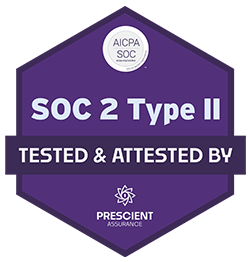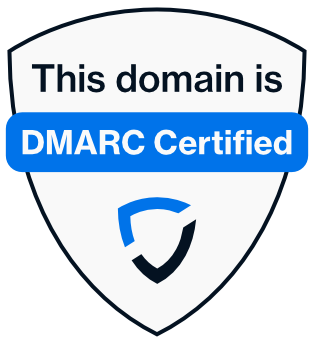Blog article
- 23 January 2025
- 8 minutes read

- Samantha Sutton
- Strategic Projects Manager
How Sender Policy Framework (SPF) works to strengthen email security
Email is a vital tool for business communication, but it also attracts cybercriminals who use tactics like phishing and domain spoofing to trick users. This is where the Sender Policy Framework (SPF) comes in, ensuring only authorized servers send emails from your domain.

Using an email authentication protocol like SPF can really help your company safeguard against potential cyberthreats. Without proper SPF records, your domain could become vulnerable to spoofing, leading to legitimate emails being marked as Spam.
These cyberthreats are expected to grow in popularity, with experts predicting the monthly average of spoofing emails to reach 30 000 this year. SPF is crucial in safeguarding your domain’s reputation and keeping communication flowing smoothly.
Read on to learn more about Sender Policy Framework (SPF), explore how it works, its benefits and challenges, and why optimizing it is key to securing your domain and boosting your email success.
Explaining Sender Policy Framework (SPF)
What is SPF?
Sender Policy Framework (SPF) allows a domain owner to publicly specify which servers or IP addresses are allowed to send emails on their behalf. For example, if a domain uses one service for notifications and another for marketing emails, both services need to be listed as approved senders in the SPF record. An SPF record is a type of Domain Name System (DNS) text entry that defines these authorized senders.
How does SPF work?
When a server receives an email, it checks the SPF record of the sender’s domain to see if the email comes from an authorized source. If the sender’s IP address matches an entry in the SPF record, the email passes the SPF check and is considered authentic – if it doesn’t match, the email fails the SPF check and is seen as an imitation.
The receiving server then decides how to handle the email based on its DMARC policy, which can mean accepting, quarantining, or rejecting the message.
Is SPF enough on its own?
While SPF is a strong authentication tool, it works best when used with other protocols, like DomainKeys Identified Mail (DKIM) and Domain-based Message Authentication, Reporting, and Conformance (DMARC) for a well-rounded approach to email security. This combination helps ensure that both the return path and the visible ‘From’ address are verified, enhancing defenses against email-based threats like social engineering, which 98% of cyberattacks in 2024 used.
SPF advantages & limitations
Advantages of SPF
- Enhanced security: Sender Policy Framework (SPF) acts like a shield for your domain, helping to keep it safe from phishing and spoofing attacks.
- Improved deliverability: Properly configured SPF records can make emails less likely to end up in a Spam folder. In fact, Spam messages made up over 46.8% of email traffic globally in 2024.
- Easy implementation: Setting up SPF is usually straightforward. It typically just requires adding a single DNS text record.
- Reputation protection: By showing that your business has secure and reliable email practices in place, you’re building trust with your recipients.
Limitations of SPF
- DNS lookup limits: Domain owners can only trigger a maximum of 10 DNS lookups when setting up their SPF record. This can be a bit tricky, especially if your organization is using multiple email services.
- ‘From’ header vulnerability: While SPF is helpful, it doesn’t actually verify the ‘From’ address that users see in their emails. This means the displayed address could still be fake.
- Email forwarding: If an email gets forwarded and the new sender’s IP isn’t listed in the original SPF record, the email might not pass the SPF check, which can lead to emails being sent to Spam. Because of this, only 2.5% of all Spam emails consist of scams, 73% of which are identity theft (commonly caused by phishing). But businesses can use protocols like Authenticated Received Chain (ARC) to help reduce the forwarding issue!
- Misconfigured records: If SPF records are misconfigured, it can lead to legitimate messages landing in Spam or dangerous emails dodging filters.
SPF optimization
Regularly optimizing the Sender Policy Framework (SPF) is a great way to keep your domain safe and communication effective. Email receivers can also benefit from SPF, as they can filter out unwanted and malicious emails, so they mainly receive messages from legitimate, trusted sources.
Sendmarc’s SPF management
Sendmarc provides an SPF management feature we call SPF Optimization; this helps to simplify SPF management by:
- Automating SPF optimization: Sendmarc monitors your SPF records to ensure your organization stays compliant with the 10 DNS lookup limit.
- SPF flattening: Our DMARC management platform combines and simplifies SPF records, reducing unnecessary lookups while maintaining functionality.
- Expert support: With Sendmarc, you have access to expert advice and handy tools, such as our SPF Lookup Tool and SPF Policy Test, which makes SPF management simple, letting your team focus on other tasks.
By working with Sendmarc, businesses can optimize their SPF records, enhance email deliverability, ensure top-notch email authentication, and enhance their defenses against threats like phishing emails, almost 5 million of which were detected in 2023.
Ready to implement SPF?
Understanding and implementing the Sender Policy Framework (SPF) is essential for protecting your company’s email communications. By setting up and regularly updating SPF records – plus exploring optimization – your organization’s defenses will be more secure against constantly evolving email-based threats.
With Sendmarc’s DMARC management platform, configuring and optimizing SPF is simple, allowing you to maintain strong email security with minimal stress. Take the first step towards effortless email security with Sendmarc’s comprehensive DMARC solution.






